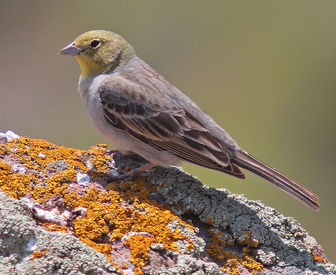Cinereous Bunting
It breeds in southern Turkey and southern Iran, and winters around the Red Sea in northeast Africa and Yemen. A few isolated populations just about maintain a foothold within European borders, on islands in the Aegean Sea. Cinereous Bunting breeds on dry stony mountain slopes. Its normal clutch is three eggs.

Original source: Mark S JoblingPermission(Reusing this file)Own work
Author: Mark S JoblingPermission(Reusing this file)Own work
Permission: GNU Free Documentation License
The Cinereous Bunting is classified as Near Threatened (NT), is close to qualifying for or is likely to qualify for a threatened category in the near future.
The Cinereous Bunting is one of Europe's least known breeding species. Small size (L 16 cm), very pale in colour but with a greenish-yellow tinge mainly on throat and head. Breeding bird of slopes with scarce vegetation , intermixed with shrubs and rocky outcrops at low altitudes. The diet seems to be principally seeds and small invertebrates. Migrant. More
The Cinereous Bunting, Emberiza cineracea, is a bird in the bunting family Emberizidae, a passerine family now separated by most modern authors from the finches Fringillidae It breeds in southern Turkey and southern Iran, and winters around the Red Sea in northeast Africa and Yemen. A few isolated populations just about maintain a foothold within European borders, on islands in the Aegean Sea. Cinereous Bunting breeds on dry stony mountain slopes. Its normal clutch is three eggs. More
female cinereous bunting is similar to the male, but darker and duller in colour, with more streaked plumage, and a trace of yellow on the throat. The juvenile has slightly browner plumage, and is even more streaked than the female (2) (3) (5). Two subspecies of cinereous bunting are recognised, which differ mainly in the colour of the underparts, with Emberiza cineracea cineracea having a more white or grey belly, and Emberiza cineracea semenowi a brighter yellow one (2) (4). More
Cinereous Bunting breeds on dry stony mountain slopes. Its normal clutch is three eggs. Cinereous Bunting is a large (16–17 cm), slim bunting with a long, white-cornered tail. It is less streaked than many buntings and has a thick pale bill. More
Cinereous Bunting determination Similar species Emberizidae Black-Faced Bunting | Black-Headed Bunting | Chestnut Bunting | Cinereous Bunting | Cirl Bunting | Corn Bunting | Cretzschmars Bunting | Dark-Eyed Junco | Fox Sparrow | House Bunting | Lapland Longspur | Little Bunting | Ortolan Bunting | Pallass Bunting | Pine Bunting | Red-headed Bunting | Reed More
| Cinereous Bunting in English | Cinereous Bunting in Spanish | Cinereous Bunting in German Use Babylon to translate to various languages Copyright © 1997-2007 Babylon. More
For the purposes of our bird news services, Cinereous Bunting is classed as ungraded: species which are unlikely to appear as wild birds in Britain or Ireland (Note that rarity levels are currently applied nationally and may not reflect local variations in abundance. More
No Cinereous Buntings were seen this morning, but birding was very good otherwise. At least 3 pairs of Cretzchmar's Bunting and a pair of Cirl Buntings were present, and on the slopes probably up to 3 different Black-eared Wheatears, 2 dark and 1 light throated. One of these had a group of 4 birders keenly trying to identify it as Finsch's. More
A Cinereous Bunting had been ringed here and was still around, probably two! At the football field there was a very approachable Sociable Plover which gave wonderful views to the audience. The Cinereous Bunting was quickly found at the entrance among some Cretzschmar’s Buntings. An incredibly beautiful bird. At the Saltpans at km 20 we had short but good views of two Great Black-headed Gulls. More
Cinereous Bunting, United Arab Emirates, Jebel Hafeet, Al Ain 19th April 2008 © Ian Boustead Birds of UAE website Cinereous Bunting - Cinereous Bunting, Greece, Lesvos 4/04 © Simon Woolley Full trip report and many images at http://www.jjcskw.demon.co. More
Family : Emberizidae
Genus : Emberiza
Species : cineracea
Authority : Brehm, 1855

